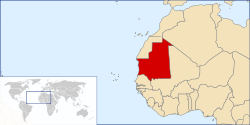

The cuisine of Mauritania, including the culinary practices of Mauritania, has been influenced by Arab, Berbers and African peoples who have lived in and traversed the "stark" landscape marked with Sahara desert dunes in caravans. [1] There is an overlap with Moroccan cuisine in the north and Senegalese cuisine in the south. [1]
Contents
French colonial influence (Mauritania was a colony until 1960) has also played a role in influencing the cuisine of the relatively isolated land. [1] Alcohol is prohibited in the Muslim faith and its sale is largely limited to hotels. [2] [1] Mint tea is widely consumed [1] and poured from height to create foam. [3] Traditionally, meals are eaten communally. [3]

